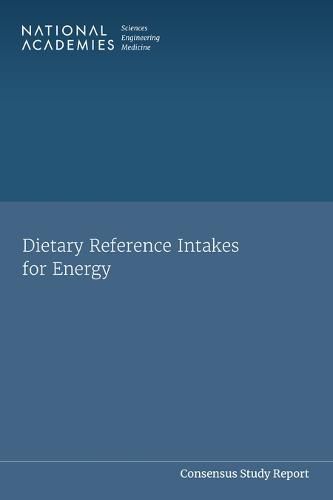Readings Newsletter
Become a Readings Member to make your shopping experience even easier.
Sign in or sign up for free!
You’re not far away from qualifying for FREE standard shipping within Australia
You’ve qualified for FREE standard shipping within Australia
The cart is loading…






The Dietary Reference Intakes (DRIs) are a set of reference values that encompass a safe range of intake and provide recommended nutrient intakes for the United States and Canada. The DRIs for energy are used widely to provide guidance for maintaining energy balance on both an individual and group level.
U.S. and Canadian governments asked the National Academies to convene an expert committee to examine available evidence and provide updated Estimated Energy Requirements (EERs) for their populations. The resulting report presents EER equations that provide a baseline for dietary planners and assessors who are estimating energy needs and monitoring energy balance to enhance the general health of individuals and populations.
Table of Contents
Front Matter Summary 1 Introduction 2 Overview of the DRI Process 3 Methodological Approach to Gathering Evidence 4 Factors Affecting Energy Expenditure and Requirements 5 Development of Prediction Equations for Estimated Energy Requirements 6 Assessing Energy Intakes, Physical Activity, and Indicators of Overweight and Obesity 7 Applications of the Dietary Reference Intakes for Energy 8 Risk Characterization and Public Health Implications 9 Research Recommendations Appendix A: Acronyms and Abbreviations Appendix B: Committee Member Biographies Appendix C: Open-Session Agendas Appendix D: Literature Search Strategies and Results Appendix E: Key Questions and Eligibility Criteria Appendix F: AMSTAR 2 Tool Appendix G: Data Analysis Report Appendix H: Characteristics of the DLW Database Appendix I: Characteristics of the DLW Validation Studies Appendix J: Summary of Data Extracted from Systematic Reviews and Other Reviewed Literature Appendix K: Interview Processes Used in National Surveys Appendix L: National Survey Data from the United States and Canada Appendix M: Estimated Energy Requirements by Body Weight Status
$9.00 standard shipping within Australia
FREE standard shipping within Australia for orders over $100.00
Express & International shipping calculated at checkout
The Dietary Reference Intakes (DRIs) are a set of reference values that encompass a safe range of intake and provide recommended nutrient intakes for the United States and Canada. The DRIs for energy are used widely to provide guidance for maintaining energy balance on both an individual and group level.
U.S. and Canadian governments asked the National Academies to convene an expert committee to examine available evidence and provide updated Estimated Energy Requirements (EERs) for their populations. The resulting report presents EER equations that provide a baseline for dietary planners and assessors who are estimating energy needs and monitoring energy balance to enhance the general health of individuals and populations.
Table of Contents
Front Matter Summary 1 Introduction 2 Overview of the DRI Process 3 Methodological Approach to Gathering Evidence 4 Factors Affecting Energy Expenditure and Requirements 5 Development of Prediction Equations for Estimated Energy Requirements 6 Assessing Energy Intakes, Physical Activity, and Indicators of Overweight and Obesity 7 Applications of the Dietary Reference Intakes for Energy 8 Risk Characterization and Public Health Implications 9 Research Recommendations Appendix A: Acronyms and Abbreviations Appendix B: Committee Member Biographies Appendix C: Open-Session Agendas Appendix D: Literature Search Strategies and Results Appendix E: Key Questions and Eligibility Criteria Appendix F: AMSTAR 2 Tool Appendix G: Data Analysis Report Appendix H: Characteristics of the DLW Database Appendix I: Characteristics of the DLW Validation Studies Appendix J: Summary of Data Extracted from Systematic Reviews and Other Reviewed Literature Appendix K: Interview Processes Used in National Surveys Appendix L: National Survey Data from the United States and Canada Appendix M: Estimated Energy Requirements by Body Weight Status